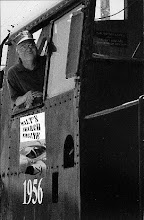From ABDA to Desert Storm and the lesson missed by Bush/Cheney
During the Desert Shield buildup in the fall of 1990, two World War II names came together again for the first time in close to 49 years: Admiral Thomas C. Hart and Witte de With. American Admiral Hart was the first naval commander of ABDA, the American, British, Dutch and Australian unified command set up on the island of Java in January 1942. The Witte de With was a Dutch destroyer in his command. Their job was to stop the Japanese advance on the Netherlands East Indies, now Indonesia.
As part of the Desert Shield almost 49 years later, the American Navy sent the frigate USS Thomas C. Hart with the USS Saratoga battle group. The Dutch stationed two frigates in the Middle East at the same time, one of which was a new HNMS Witte de With.
The frigates Thomas C. Hart and Witte de With became part of a far more successful military operation than their namesakes of 1942.
Admiral Hart attempted to instantaneously weld the four World War II navies into an ABDA Unified Naval Command. But Japanese forces sank most of the Allied ships in their path. The destroyer Witte de With, after escorting the wounded heavy cruiser HMS Exeter from the Battle of the Java Sea, was bombed by the Japanese at Surabaya on March 1, 1942. She was scuttled and abandoned the following day.
ABDA was the first attempt at a multi-national, unified command in the 20th century. Hastily assembled after the Pearl Harbor disaster, ABDA faced the full weight of the Japanese assault in the far east. It failed to stop them at sea, on land and in the air.
Desert Storm was fought by an international, unified military command. But this time it was a resounding success, capable of capturing far more than it was authorized to subdue.
ABDA involved just four nations in 1942. Those four nations squabbled over tactics and who should be in charge. Their communication systems, training and ships didn't mesh into cohesive fighting units. They hadn't planned and trained together to fight a common enemy. They weren't prepared.
As a result, in 1942 the British surrendered Singapore and 70,000 troops in Malaya to the Japanese. The Dutch lost their East Indies Empire, two cruisers and all seven destroyers in their far eastern fleet. Australia lost fighting men and the HMAS Perth, a modern light cruiser. And the United States lost the Philippines, thousands of fighting men, the USS Pope, a World War I vintage destroyer and the USS Houston, a modern, heavy cruiser, one of President Franklin Roosevelt's favorite warships.
ABDA's inability to stop the Japanese in 1942 wasn't due to any deficiencies in the fighting men from the four Allied nations. Chris Droste, a harbor pilot at Tjilatjap on the southern coast of Java in 1942, wrote in his book, Till Better Days, that the American and Allied sailors were far from demoralized before the battles. Knowing that the odds were stacked against them, "...they went as hounds to a hunt, agitated only that they might miss the opening clash."
Desert Storm's success as a unified command in 1991 is a testimonial to the heroism and sacrifice of ABDA soldiers, airmen and sailors. It was in the waters around Java, on Javanese beaches and in the air over Java in the first three months of 1942 that the Allies learned that cooperation in training, that standard equipment and communications were required to defeat a powerful and determined enemy.
That knowledge enabled 28 nations, led by the US under the UN banner, to defeat Iraqi aggression in Kuwait. President George W. Bush and Vice President Cheney ignored this valuable lesson when they launched the US attack on Iraq in 2003. The attack wasn't authorized by the UN, wasn't really authorized by the American people because of the lies they were fed, wasn't supported by enough armed forces and wasn't supported by most of our Allies.
It has been a disaster, launched by men who have never served in the active armed forces (and did everything they could to be certain of that), have never studied military history and have never failed to use deception to get their way.--Copyright 2007 by Walter Haan. www.war-books.com

